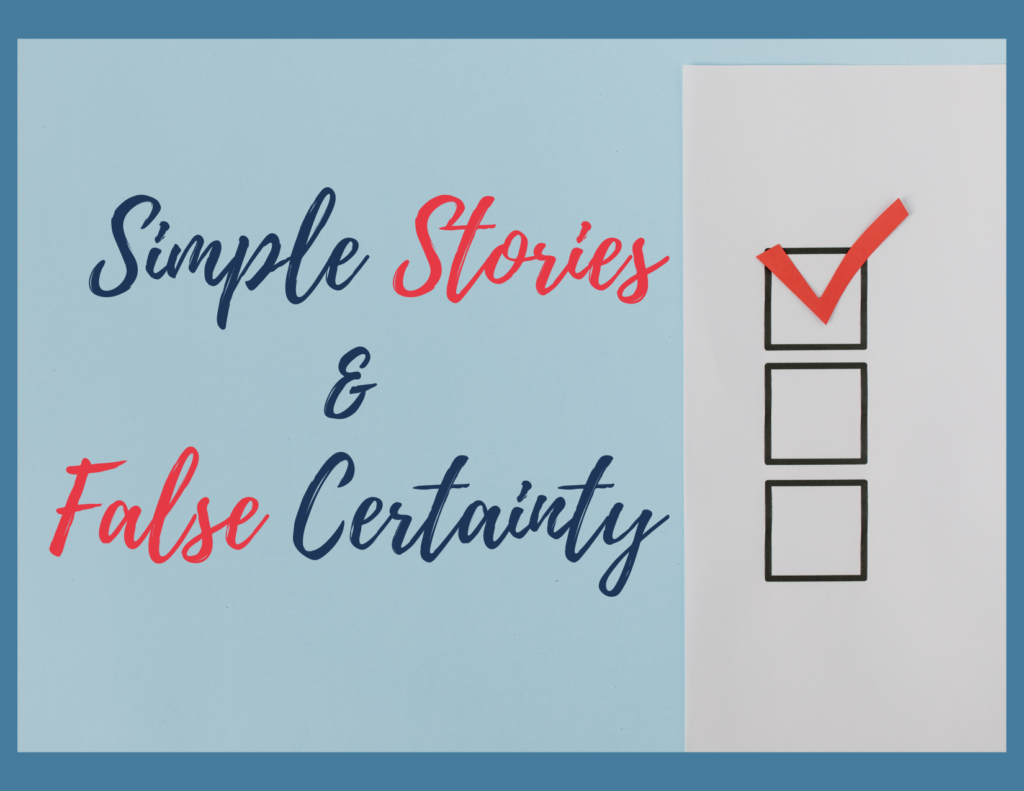Have you ever been in a situation where you convinced yourself that you knew what was happening, only to discover later that you had it completely wrong because you created a narrative to fill in the gaps? Our brains are hard-wired to try to connect dots, and in the absence of information, we tend to create a false link by making up stories to make us feel sure we know what is going on. Unfortunately, this usually leads to a false sense of certainty.
Here is an example of how this might play out. Two weeks ago, I connected with a colleague who said they wanted to set up a coffee meeting with me. I have not heard from her. Immediately, my brain has constructed a narrative: She’s still upset about the feedback I gave during our last project meeting that followed our coffee conversation. She’s deliberately ignoring me. This relationship is damaged. Sound familiar?
How Simple Stories Block Solutions
When we embrace these simplified narratives, several things happen that actively prevent us from finding solutions:
- We stop asking questions because we think we already know the answer.
- We filter out information that contradicts our story.
- We assign people simple roles (hero, villain) rather than seeing their complexity.
- We limit our perspective and assume a predetermined outcome.
By recognizing when we’re trapped in these stories and embracing inquiry instead, we can unlock better leadership and problem-solving abilities.
About three years ago, I read a book by Jennifer Garvey Berger that helped me see my blind spots in creating false narratives and simple stories. “Unlocking Leadership Mindtraps: How to Thrive in Complexity” is an insightful book and masterclass in identifying and understanding the mental patterns that can derail us in an ever-increasingly complex world.
Breaking Free Through Inquiry
The key to escaping the simple stories trap isn’t to stop creating stories altogether, that’s impossible. Instead, Berger suggests you need to “notice your simple stories, remember they’re simple, believe in them less, and use this habit to multiply the options you are considering.”
Here are some powerful inquiry-based approaches from Berger’s work:
1. Ask: “How is this person a hero in their own story?”
One of Berger’s most powerful suggestions is to intentionally reframe how we see others. When you find yourself casting someone as the villain in your narrative, try asking: “How is this (annoying and frustrating) person a hero?” In other words, can you step into their shoes and see the situation through their eyes?
This isn’t excusing bad behavior. Understand that people don’t necessarily go home each night thinking about how they wronged you. They have their own narrative where they’re acting reasonably, perhaps even heroically.
2. Carry Three Alternative Stories
Berger challenges us to generate and carry three different stories about what happened in any given situation. This practice creates cognitive flexibility and helps us avoid becoming locked into a single interpretation.
3. Separate Facts from Interpretation
Before jumping to conclusions, take a moment to separate what actually happened (observable facts) from your interpretation of those events. This simple practice creates space for inquiry and prevents the automatic acceptance of our first interpretation.
Putting This Into Practice
Here’s a simple framework based on Berger’s work that you can use when you catch yourself in a simple story:
- Pause and Notice: Recognize when you’re creating a simple narrative. Look for signs like certainty, emotional reactions, or black-and-white thinking.
- Extract the Facts: What actually happened, stripped of all interpretation? What did you actually see or hear?
- Generate Alternatives: What are three other possible explanations for what occurred? Make them as plausible as your original story.
- Get Curious: What questions could you ask to learn more? What information might you be missing?
- Expand Possibilities: How does each alternative story open up different solution paths?
As you move through your week, I challenge you to catch yourself in the act of creating simple stories. Notice how your brain weaves incomplete information into compelling narratives, and practice generating alternatives. Most importantly, embrace inquiry, ask questions rather than assuming you already know the answers.
Want to Learn More?
If you found this helpful, I highly recommend reading Jennifer Garvey Berger’s book, “Unlocking Leadership Mindtraps: How to Thrive in Complexity.” It’s a book I recommend to all my executive coaching clients. It explores five mind traps in depth and offers practical strategies for escaping them.
This article explores just one of the five mindtraps Berger identifies. The other four mindtraps are rightness, agreement, control, and ego.







